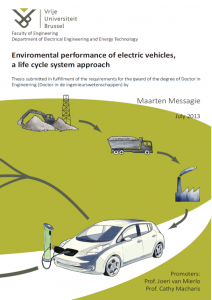
How to compare the environmental performance of different vehicle technologies? Vehicles with lower tailpipe emissions are perceived as cleaner. However, does it make sense to look only to tailpipe emissions? Limiting the comparison only on these emissions denies the fact that there are emissions involved during the production of a fuel and gives too much advantage to zero-tailpipe vehicles like battery electric vehicles (BEV). Would it be enough to combine fuel production and tailpipe emissions? Especially when comparing the environmental performance of alternative vehicle technologies the emissions during production of the specific components and their appropriate end-of-life treatment processes should also be taken into account. So the complete life cycle of the vehicle should be included in order to avoid problem shifting from one life phase to another. A vehicle’s life cycle can be divided into four stages: vehicle production from extraction of raw materials to delivery of the complete product, production of the fuel and/or electricity used by the vehicle during its life, the impact of vehicle use, and finally vehicle disposal at the end of its life. Within this study, a full LCA of Petrol, Diesel, Compressed Natural Gas (CNG), Liquefied Petroleum Gas (LPG), Hybrid Electric, Battery Electric (BEV) an plug-in hybrid vehicles (PHEV) has been performed with a range based LCA approach.
Promotor: Prof. Dr. Joeri Van Mierlo
Co-Promotor: Prof. Dr. Cathy Macharis
Committee members: Prof. Hubert Rahier; Prof. Rik Pintelon; Prof. Thierry Coosemans; Prof. Anne-Marie Tillman; Dr. Jan Mertens
